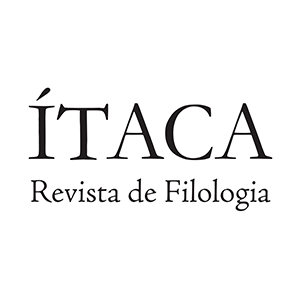Transfer in third language phonology: Does L3 typological proximity play a role?
DOI:
https://doi.org/10.14198/ITACA2015.6.16Paraules clau:
Model de Millora Acumulativa, Interferència lingüística, Aprenentatge de L3, Transferència fonológicaResum
Les investigacions recents sobre la transferència i l'adquisició d’una L3 han indagat sobre les interferències lingüístiques quan hi ha més d'una font de transferència. Els participants en aquest estudi de cas van ser parlants d’espanyol i d’anglès, que apreninen una tercera llengua, el català, tipològicament més pròxima a l’espanyol. Aquest estudi va investigar la producció dels bilingües del català fosc /ɫ/, un segment que no és present en espanyol ja que tots els laterals es produeixen com una clara /l/, i que, tanmateix, es realitza en anglès en posició final després de vocal. Contràriament al model que planteja la proximitat d'idiomes prèviament adquirids com un dels factors determinants per a la transferència de competències, l’estudi va mostrar que la proximitat tipològica a un dels L1 no és determinista per a la transferència en el nivell fonològic en l’aprenentatge d’una L3, ja que els participants produeixen laterals catalanes similars a /ɫ/. En aquest estudi de cas es constata, d’acord amb el Model de Millora Acumulativa, com es transfereix aquest segment fonològic des de l’anglés al català.Referències
BAYONA, P. (2009): «Crosslinguistic Influences in the Acquisition of Spanish L3», Ann Arbor, ProQuest. 70 (12), The University of Western Ontario (Canada), p. 46-54.
BOERSMA, P. & D. WEENINK (2009): Praat: doing phonetics by computer (Version 5.1.04) [Computer program]. http://www.praat.org/
BARDEL C. and Y. Falk (2007): «The role of the second language in third language acquisition: The case of Germanic syntax Second Language Research 23, p. 459-484.
CABRELLI AMARO, J. & J. Rothman (2010): «On the L3 acquisition and phonological permeability: A new test case for debates on the mental representation of non-native phonological system», International Review of Applied Linguistics in Language Teaching, 48 (2/3), p. 275-296.
CABRELLI AMARO, J. (2012): L3 Phonology: An Understudied Domain. In J. CABRELLI AMARO, S. FLYNN, & J. ROTHMAN (Eds.), Third Language Acquisition in Adulthood, Amsterdam, John Benjamins, p. 33-60.
ECKE, P & C. J. HALL (2000): «Lexicalilische Fehler in Deutch als Drittsprache. Translexikalischer Einfluss aud dre Ebenen der mentale Reprasentation», Deutch als Fremdsprache, 37, p. 30-36.
ELLIS, G. (1996): «How culturally appropriate is the communicative approach?», ELT journal, 50 (3), p. 213-218.
FLYNN S., C. FOLEY & I. Vinnitskaya (2004): «The cumulativeenhanced model for language acquisition: Comparing adult’s and children’s parents of development in first, second and third language acquisition of relative clauses», The International Journal of Multilingualism, 1, p. 3-16.
GARCIA LECUMBERRI, M. & F. GALLARDO (2003): «English EFL sounds in school learners of different ages», in M. GARCIA MAYO & GARCIA LECUMBERRI (ed.), Age and the Acquisition of English as a Foreign Language, Clevedon, Multilingual Matterns, p. 115-135.
GUT, U. (2010): «Cross-linguistic influence in L3 phonological acquisition», International Journal of Multilingualism, 7 (1), p. 19-38.
HUALDE, J. I. (2005): The sounds of Spanish, Cambridge, Cambridge University Press.
KELLERMAN, E. (1983): Now you see it, now you don’t, in S. GASS & L. SELINKER (ed.), Language transfer in language learning. Rowley, Newbury house, p. 112-134.
MARIAN, V., H. K. BLUMENFELD & M. KAUSHANSKAYA (2007): «The Language Experience and Proficiency Questionnaire (LEAP-Q): Assessing language profiles in bilinguals and multilinguals», Journal of Speech, Language, and Hearing Research, 50 (4), p. 940-967.
MONTRUL, S., R. Dias & H. SANTOS (2011): «Clitics and object expression in the L3 acquisition of Brazilian Portuguese. Structural similarity matters for transfer. Special issue of Second Language Research on L3 Acquisition.
PYUN, K. (2005): «A model of interlanguage analysis. The case of Swedish by Korean speaker», in B. Hufesein and R. J. Fouser (ed.), Introductory Readings in L3, Tubingen, Stauffenburg Verlag, p. 55-70.
RECASENS, D., J. Fontdevila & M. D. PALLARES (1995): «Velarization degree and coarticulatory resistance for /l/ in catalan and german», Journal of Phonetics, 23 (1-2), p. 37-52.
RECASENS, D. & A. ESPINOSA (2005): «Articulatory, positional and coarticulatory characteristics for clear /l/ and dark /ɫ/:Evidence from two Catalan dialects», Journal of the International Phonetic Association, 35, p. 1–25.
RECASENS, D. (2004): «Darkness in [l] as scalar phonetic property: Implications for phonology and articulatory control», Clinical Linguistics and Phonetics, 18, p. 593–603.
ROTHMAN, J. & J. CABRELLI AMARO (2010): «What variables condition syntactic transfer?: a look at the L3 initial state», Second language Research 26, 2, p. 189-218.
ROTHMAN, J. (2010): «L3 Syntactic transfer selectivity and typological determinacy: The typological primacy Model», Second Language Research 27 (1), 107-127.
SOLÀ, J. & G. Rigau i Oliver (2002): Gramàtica del català contemporani, Barcelona, Empúries.
Descàrregues
Estadístiques
Publicades
Com citar
Número
Secció
Llicència
Drets d'autor (c) 2015 Dámaris Mayans

Aquesta obra està sota una llicència internacional Creative Commons Reconeixement 4.0.




